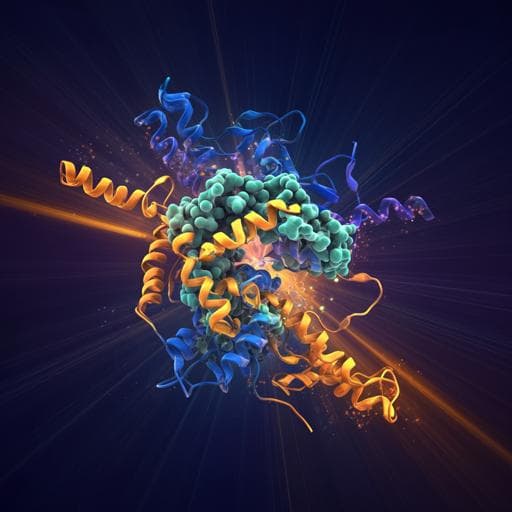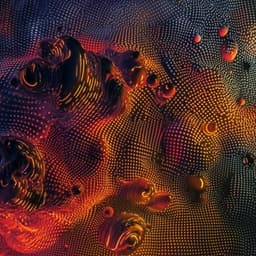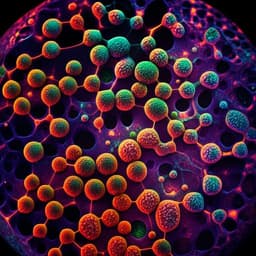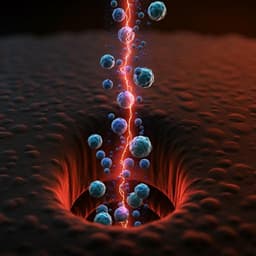
Biology
Ultraviolet optical horn antennas for label-free detection of single proteins
A. Barulin, P. Roy, et al.
This groundbreaking research, conducted by Aleksandr Barulin, Prithu Roy, Jean-Benoît Claude, and Jérôme Wenger, explores a revolutionary nanophotonic platform that enables label-free detection of single proteins using their intrinsic UV autofluorescence. The study highlights the ability to monitor protein behaviors in real-time, paving the way for deeper insights into proteins in their native states.
~3 min • Beginner • English
Introduction
The study aims to directly detect and analyze single proteins in their native state without external fluorescent labels by leveraging the intrinsic ultraviolet (UV) autofluorescence of tryptophan/tyrosine residues. Conventional single-molecule fluorescence techniques often require labels that can perturb protein structure or interactions. However, detecting native UV autofluorescence is challenging because proteins are much dimmer than organic dyes and much of the emission near interfaces is radiated at large angles (forbidden or supercritical light), while available UV objectives have limited numerical apertures (typically ≤0.8). The research addresses these limitations by engineering a broadband optical platform that enhances excitation/emission, efficiently collects high-angle emission, and suppresses background, thereby enabling label-free single-protein detection, including real-time monitoring of dynamics such as unfolding and dissociation.
Literature Review
Prior work established single-molecule fluorescence as a powerful tool but with labeling-induced artifacts (e.g., structural perturbations, altered interactions, and nonspecific binding). Label-free single-molecule detection alternatives (plasmonic scattering, nanomechanical mass spectrometry, nanopores) have advanced but do not provide the same benefits as fluorescence readouts. UV autofluorescence of proteins (mainly tryptophan) is an attractive label-free route, yet low brightness and optical collection constraints have hindered single-protein detection. Optical antennas in the visible have provided large fluorescence enhancements using resonant, often narrowband plasmonic designs (bowties, antenna-in-box, nanorods, corrugated apertures), but these approaches are less compatible with UV protein detection due to spectral narrowness, fabrication complexity, or need for solid-state emitters. Supercritical-angle emission near interfaces further limits collection with low-NA UV optics. These gaps motivate a broadband, fabrication-feasible UV-compatible antenna that boosts both radiative rate and collection while minimizing background for native protein studies.
Methodology
Design and concept: A UV optical horn antenna combines (i) a central metal nanoaperture that concentrates excitation and enhances emission in an attoliter volume and (ii) a conical metal-coated reflector that redirects high-angle fluorescence into a 0.8 NA objective. The horn is intrinsically broadband over 300–400 nm (non-resonant), addressing UV autofluorescence of proteins.
Nanofabrication: Horns were milled in quartz coverslips (NEGS1, 150 μm) by focused ion beam (FEI DB235; 30 kV, 300 pA for horn; 10 pA for aperture). A 100 nm Al film was deposited by e-beam evaporation (Bühler Syrus Pro 710, 10 nm/s, 10−6 mbar) to ensure high UV reflectivity. A central nanoaperture (65 nm or 200 nm diameter) was milled on the horn top plateau; all apertures included a 50 nm undercut into quartz to maximize enhancement. A 12 nm SiO2 protective layer was added by PECVD (PlasmaPro NGP80) to prevent Al corrosion. Horn cone angles from 10–55° were fabricated; optimized performance was found near 32–35°.
Samples and buffers: Proteins: β-galactosidase (E. coli, 156 Trp), β-galactosidase–streptavidin conjugate (180 Trp), and streptavidin (S. avidinii, 24 Trp) from Sigma-Aldrich. Dissolved in Hepes buffer (25 mM Hepes, 300 mM NaCl, 0.1% v/v Tween20, 1 mM DTT, 1 mM EDTA, pH 6.1). Stocks centrifuged (12 min, 142,000×g). Immediately before measurements, GODCAT oxygen scavenger (100 nM glucose oxidase, 830 nM catalase, 10% w/v D-glucose) and 10 mM DABCO were added to improve UV photostability. p-Terphenyl (93% QY) in cyclohexane served as calibration dye.
Surface functionalization and immobilization: Substrates cleaned with UV-ozone, ethanol, and O2 plasma. Quartz surfaces coated with PEG-silane (1000 Da) plus biotin-PEG-silane (2000 Da) by overnight incubation in ethanol solution (0.75 mg PEG-silane, 1.2 mg biotin-PEG-silane). After rinsing/drying, protein solutions (5 nM or 0.1 nM) were incubated 30 min to bind streptavidin anchors to surface-grafted biotin, followed by rinsing and imaging in photostabilizing buffer.
Control labeling experiments: β-galactosidase–streptavidin mixed 1:1 with Atto647N–biotin to achieve ~1 dye per protein (probability >1 label <4%) and immobilized with the same protocol. Readout on a confocal microscope (635 nm, 1 μW) with GODCAT and 1 mM Trolox/Trolox-quinone for stability.
Diffusing proteins: To slow diffusion and increase residency time, 55% w/w sucrose was added (∼30× viscosity increase). Nanoaperture diameter of 200 nm was used to balance dwell time and throughput. Concentrations up to 20 nM were chosen to keep average occupancy <0.12 molecules in the aperture volume.
Urea denaturation: 1.7 μM β-galactosidase incubated with 0–6 M urea (pH 7) for 90 min at room temperature; 0.4% v/v Tween20 to minimize aggregation. Horn surfaces passivated with PEG-silane 1000 Da (1 mg/mL in ethanol + 1% acetic acid, 3–4 h). GODCAT added just before measurements; urea concentration maintained during acquisition.
Microscopy and detection: Custom confocal microscope with LOMO 58×/0.8 NA water objective. Excitation: 266 nm picosecond laser (p-terphenyl; 70 ps; 80 MHz; 80 μW average) and 295 nm picosecond laser for proteins (selective Trp excitation; 70 ps; 80 MHz). Laser power: immobilized proteins 0.3 μW; diffusing proteins 8 μW; urea experiments 10 μW. Excitation filtered (Semrock FF01-311/SP-25) and reflected by dichroic (Semrock FF310-Di01-25-D). Emission collected through the same objective, filtered (Semrock FF01-300/LP-25 and FF01-375/110-25), confocally detected (Thorlabs ACA254-200-UV, 80 μm pinhole), and counted on a PMT (Picoquant PMA 175) with time-tagged time-resolved electronics (PicoHarp 300). Detection spectral window: 310–410 nm. Typical integration time 2–3 min; horn antennas localized using LED imaging; UV excitation turned on only at acquisition start to minimize photobleaching during scanning.
Data analysis: Immobilized label-free time traces binned at 300 ms and fit to Ae^(−t/τ) + y0; amplitude A used to build histograms. Atto647N control traces analyzed with AutoStepfinder to count bleaching steps and estimate protein number per antenna. Diffusing protein traces (30 ms bins) high-pass filtered at 1 Hz to remove slow drifts before histogramming; thresholding at 2.5× noise σ defined from no-protein control. FCS performed and fit with a 3D Brownian diffusion model including blinking and background terms; aspect ratio ω ≈ 1 for horn, ≈8 for confocal. Fluorescence lifetime decays fit by iterative reconvolution with a 3-exponential model (10 ps fixed metal/Raman component, long confocal-like tail, and dominant intermediate lifetime inside the horn). Simulations: FDTD (RSoft FullWave) at 350 nm with 2 nm mesh; horizontal/vertical dipoles averaged; computed collection gain into 0.8 NA vs. single aperture; cone angles from 10–55° simulated and fitted with a Gaussian to compare to experiments.
Key Findings
- Broadband UV horn antenna (conical Al reflector + central nanoaperture) provides simultaneous excitation/emission enhancement, efficient collection of supercritical emission, and background rejection, enabling label-free single-protein UV autofluorescence detection.
- p-Terphenyl calibration: brightness enhancement vs confocal ~15× with optimized horn (vs ~4× for bare nanoaperture); optimal cone angle ~35°. Fluorescence lifetime reduced ~3× in nanoaperture/antenna vs confocal, independent of cone angle, indicating aperture-determined LDOS; additional gain from horn arises from increased directivity/collection. Simulations match angle-dependent collection trends. Maximum collection angle estimated ~85° for 32° cone.
- Immobilized proteins: Using β-galactosidase–streptavidin, Atto647N control yields Poisson-distributed occupancy (avg ~2.3 proteins at 5 nM; ~0.7 at 0.1 nM). Label-free UV traces show exponential photobleaching decays; average brightness per β-galactosidase–streptavidin protein in horn ≈ 210 ± 30 counts/s (5 nM case) and 310 ± 50 counts/s (0.1 nM case). Streptavidin (24 Trp, higher Trp QY ~3.5%) gives ~2.5× lower amplitudes than β-galactosidase (156 Trp, average Trp QY ~1.6%), consistent with expected scaling. Horn gives ~3× higher signal than single nanoaperture alone under identical conditions.
- Diffusing proteins: With 55% sucrose (∼30× viscosity), single-molecule bursts from β-galactosidase–streptavidin detected at concentrations up to 20 nM (average occupancy <0.12). Burst brightness ~600 counts/s; FCS confirms signal with positive amplitude and diffusion time ~5 ms (consistent with slowed diffusion). Event rate above a 2.5σ noise threshold increases with concentration, while background-only control shows ~14 events/min at threshold.
- Denaturation/unfolding (urea): Ensemble spectra show up to ~10 nm red shift with urea but nearly constant integrated intensity (310–410 nm) and lifetime. Horn-enabled FCS (10× brightness increase vs confocal) allows quantifying hydrodynamic radius and molecule number vs urea. Below ~3.5 M urea: tetramer count constant; hydrodynamic radius increases from 6.5 ± 0.6 nm to ~9.5 nm (unfolding). Above ~3.5 M urea: hydrodynamic radius decreases to ~4 nm and detected molecule number increases by >2×, indicating tetramer dissociation into unfolded monomers. Initial hydrodynamic radius agrees with literature (∼6.7–6.85 nm).
- Operational advantage: Improved brightness enables up to ~100× reduction in integration time compared to confocal reference while maintaining accuracy in FCS analyses.
Discussion
The horn antenna overcomes fundamental limitations in UV single-molecule detection by directing supercritical emission into a moderate-NA objective while the nanoaperture provides excitation/emission enhancement and strong background suppression. This combination elevates native protein UV autofluorescence above noise, enabling single-molecule readout for immobilized and freely diffusing proteins. The platform’s sensitivity supports kinetic and conformational studies without labeling artifacts, demonstrated by real-time observation of β-galactosidase unfolding and dissociation pathways under urea denaturation. The ability to extract both molecule number (dissociation) and hydrodynamic radius (unfolding) from label-free FCS provides mechanistic insight at the single-molecule level. While lifetime reductions originate from the nanoaperture-controlled LDOS, the horn’s added value is enhanced directivity and collection, validated by simulations and experiments. Beyond UV, the broadband and non-resonant design suggests straightforward translation to the visible for improved molecular sensing, single-photon source collection, and nonlinear emitters, especially in crowded, confined environments.
Conclusion
This work introduces a broadband UV optical horn antenna that, by integrating a conical reflector with a nanoaperture, enables label-free detection of single proteins via intrinsic autofluorescence. The system enhances brightness, efficiently collects high-angle emission, and suppresses background, allowing single-molecule measurements of immobilized and diffusing proteins and revealing β-galactosidase denaturation pathways at the single-molecule level. The approach reduces measurement times substantially relative to confocal microscopy and is compatible with physiological-like concentrations due to the attoliter detection volume. Future directions include mitigating UV-induced photodamage for immobilized samples, optimizing materials and geometries for higher collection and lower background, extending the concept to visible wavelengths for broader applicability (e.g., quantum emitters, nonlinear photonics), and exploring diverse proteins and dynamic processes in native environments.
Limitations
- UV photodamage of amino acids can perturb immobilized proteins; to mitigate, very low excitation powers (∼0.3 μW) were used, which limit SNR.
- Available UV objectives have limited NA (~0.8), necessitating antenna-based collection engineering; residual collection constraints remain.
- For diffusing proteins, high-viscosity media (55% sucrose) were required to increase dwell time; sucrose impurities elevate background noise and cap usable viscosity (similar issues with glycerol).
- Signal levels depend on protein-specific Trp content and quantum yield, leading to variability; exponential photobleaching behavior complicates per-molecule step analysis for immobilized samples.
- Backgrounds from metal photoluminescence/Raman and potential detector afterpulsing require multi-exponential lifetime modeling and careful FCS fitting.
- Horn performance depends on precise nanofabrication (cone angle, aperture diameter, undercut) and surface chemistry; steric hindrance and incubation time affect occupancy control.
Related Publications
Explore these studies to deepen your understanding of the subject.







